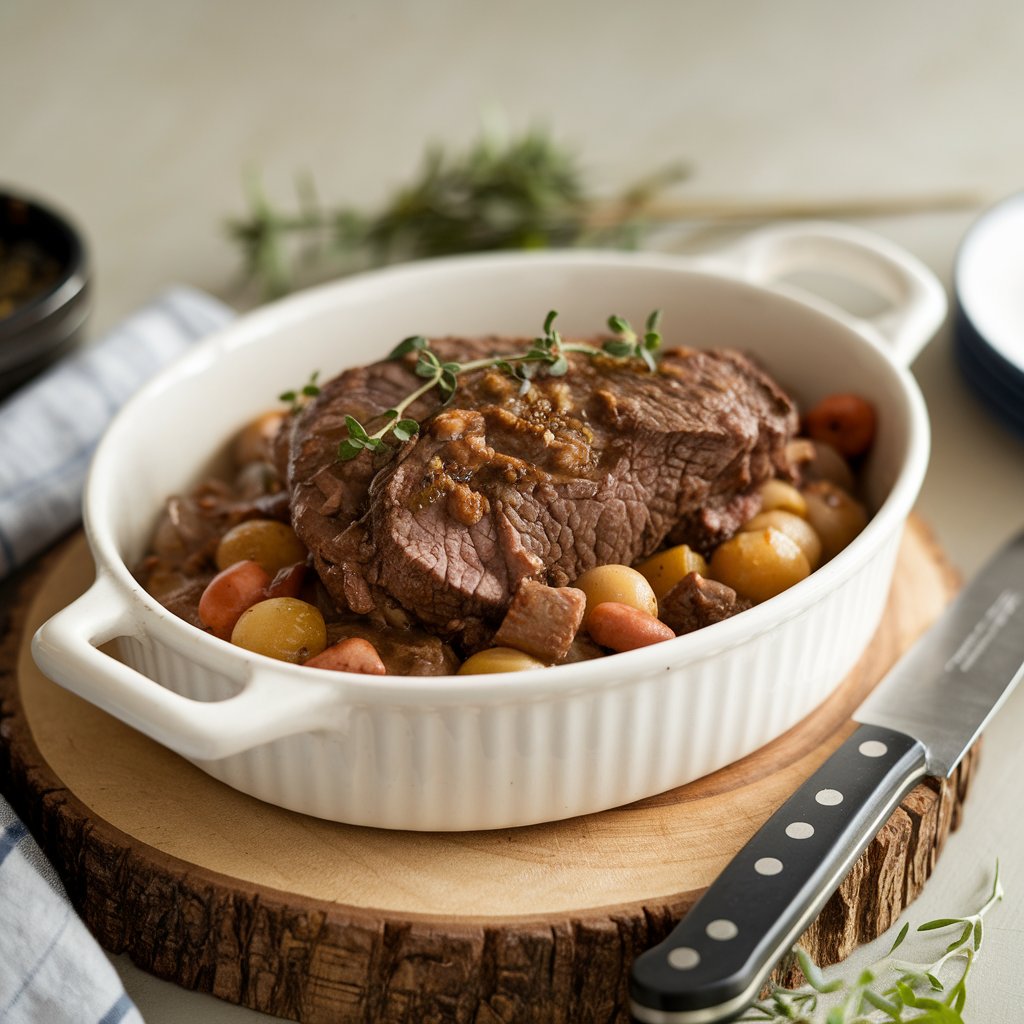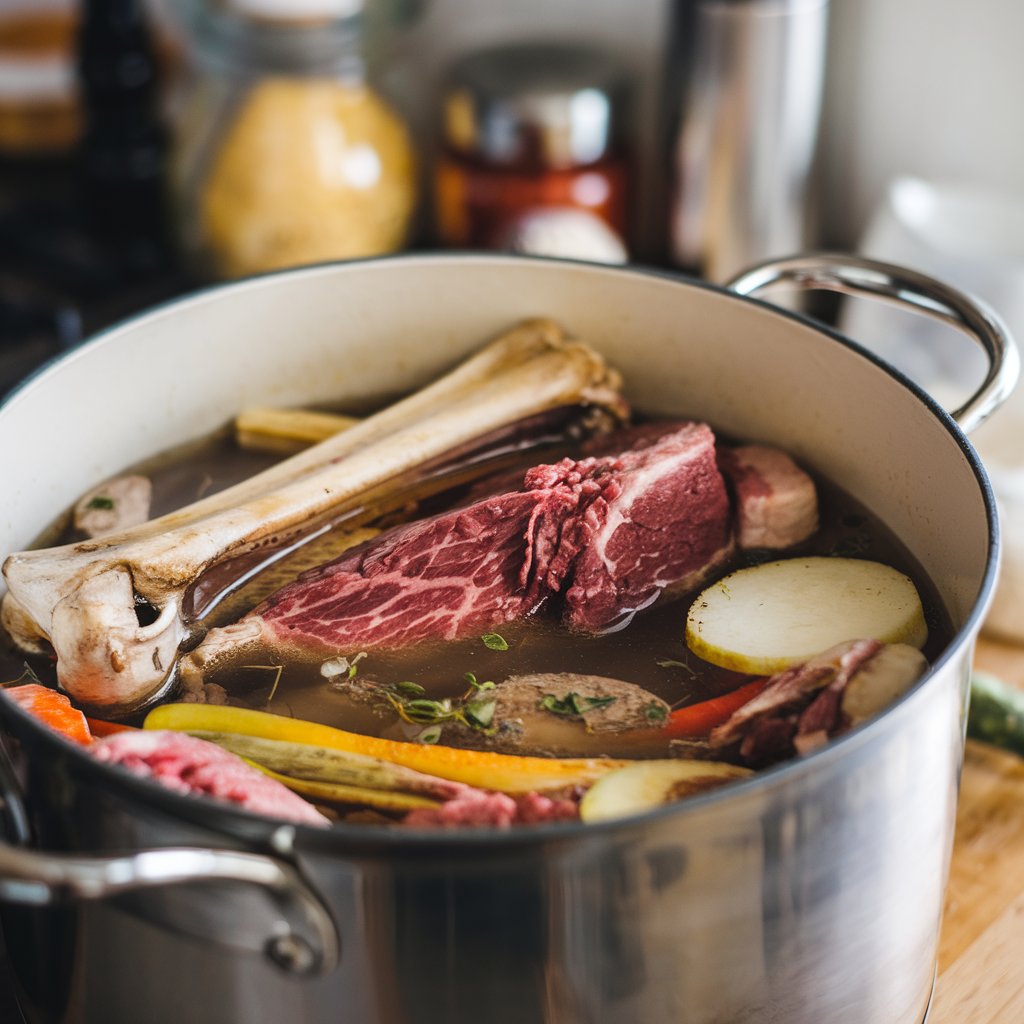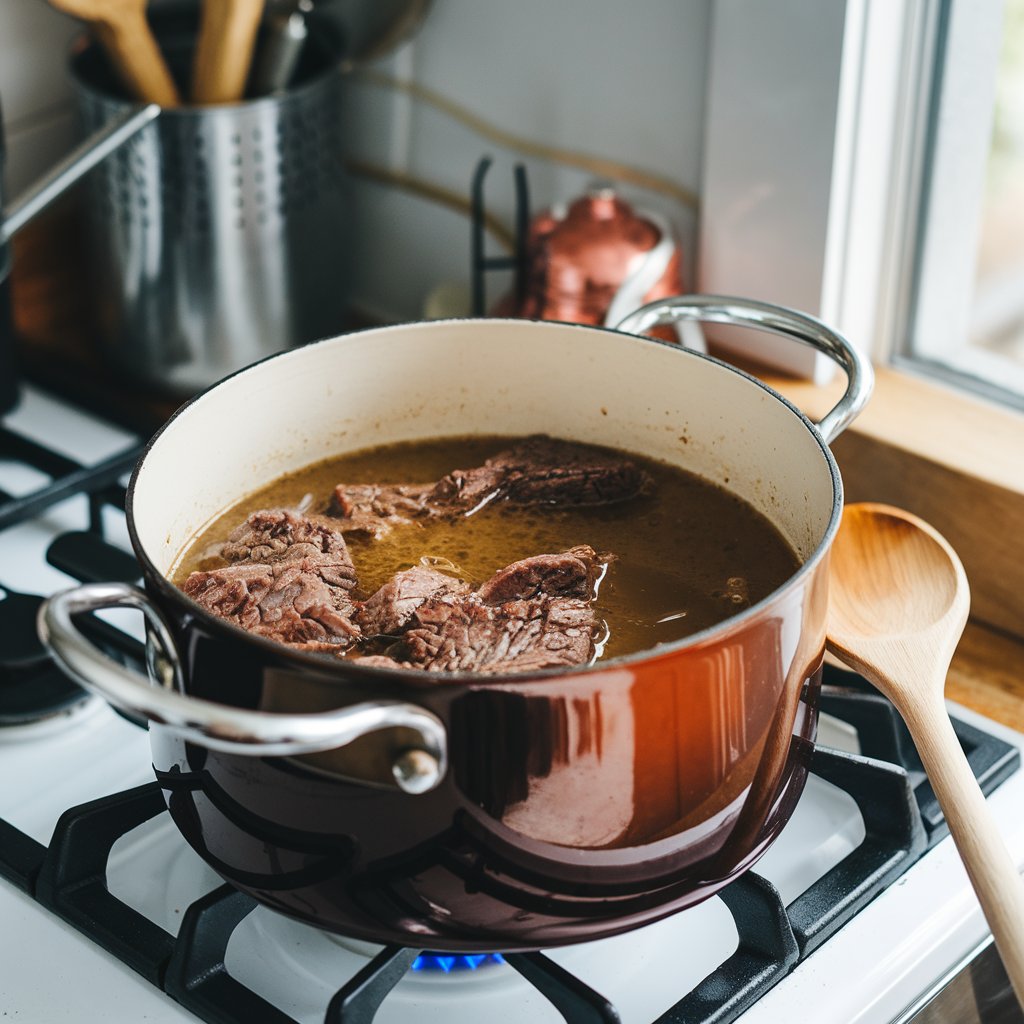Creating a homemade beef stock bone recipe is simpler than you might think. Using beef bones to make stock adds incredible depth of flavor and a wealth of nutrients, including collagen and minerals. Whether you’re preparing soups, stews, or sauces, a homemade beef stock serves as a versatile and flavorful base for your cooking.
As a seasoned home chef, I know the importance of a well-stocked kitchen. But nothing is more precious to me than the beef stock bone. It can turn a simple dish into a culinary masterpiece.
Beef bones, meat scraps, and veggies simmered together create a flavorful broth. This homemade beef stock is key to many dishes, making them stand out. It’s the heart of soups, sauces, and gravies, adding depth and richness.
Homemade beef stock is far better than store-bought versions. It’s full of flavor and nutrients. Every cook should learn to make it, opening up new possibilities in their kitchen.
Table of contents
Key Takeaways
- Beef stock bone is a fundamental component in culinary arts, creating a rich, gelatinous liquid that forms the base for soups, sauces, and gravies.
- Homemade beef stock offers superior taste and nutritional value compared to store-bought alternatives.
- The process of making beef stock involves roasting bones and vegetables, then slow-cooking them to extract flavors and nutrients.
- Homemade beef stock is a versatile ingredient that can be used in a variety of recipes, from comforting soups to complex sauces.
- Mastering the art of making homemade beef stock can unlock a world of culinary possibilities in the kitchen.
Understanding Beef Stock Bone: Culinary Foundation
Beef stock and beef broth are key in cooking, but they’re not the same. Beef stock is made by simmering bones, cartilage, and connective tissues for 4-6 hours. This process pulls out gelatin, minerals, and nutrients, making a rich, gelatinous liquid with deep flavors.
Beef broth, on the other hand, is simmered with meat, veggies, and seasonings for 1-2 hours. It’s lighter, with more protein from the meat.
Benefits of Making Stock at Home
Making your own beef stock at home has many perks. You control the quality and flavor, avoiding too much salt or preservatives. It’s also rich in gelatin, which might help with skin and joint health. uicy Baked Beef Ribs
Role in Professional and Home Cooking
In pro kitchens, beef stock is vital for boosting umami and making sauces and gravies. At home, it adds flavor and texture to soups, stews, and more. It’s a must-have for home cooks.
| Characteristic | Beef Stock | Beef Broth |
|---|---|---|
| Main Ingredients | Beef bones, cartilage, and connective tissues | Beef meat, aromatic vegetables, and seasonings |
| Simmering Time | 4-6 hours | 1-2 hours |
| Texture | Gelatinous and rich | Lighter and thinner |
| Collagen and Gelatin Content | Higher | Lower |
| Protein Content | Lower | Higher |
| Primary Use | Sauces, gravies, and braising liquids | Soups, stews, and as a beverage |

Essential Ingredients for Perfect Beef Stock Bone
Making a tasty and healthy beef stock starts with the right ingredients. At the core are top-notch beef bones, which add gelatin and flavor. It’s important to mix different beef bones like short ribs, oxtail, and marrow bones for a rich taste.
The mirepoix of carrots, celery, and onions is also key. They bring sweetness and aroma to the stock. Other aromatics like garlic, bay leaves, and thyme add more flavor and scent.
To bring out the best in these quality ingredients, roast the beef bones and veggies. This step caramelizes them, making the stock richer. It’s a crucial step for a great beef stock.
| Ingredient | Quantity |
|---|---|
| Beef Bones (Short Ribs, Oxtail, Neck, Knuckle, Shank, Marrow Bones) | 5-6 pounds |
| Mirepoix (Carrots, Celery, Onions) | 2 cups each |
| Aromatics (Garlic, Bay Leaves, Peppercorns, Parsley, Thyme) | As desired |
Choosing and preparing these beef bones, mirepoix, and aromatics carefully will help you make a delicious beef stock. This stock will make your dishes even better.

Selecting the Right Bones for Stock Making
Making a tasty and healthy beef stock begins with picking the right bones. It’s important to mix different bones for the best taste. Bones like knuckle bones, neck, and shank add richness. Meanwhile, oxtail and short ribs bring deep, savory flavors.
Types of Beef Bones
- Marrow bones: These bones have creamy marrow that makes the stock feel luxurious.
- Knuckle bones: Known as joint bones, they’re full of collagen that turns into gelatin when cooked.
- Neck and shank bones: These bones are packed with marrow and connective tissue, making the stock thick and hearty.
- Oxtail: The cow’s tail adds a rich, beefy flavor to the stock.
- Short ribs: These bones bring a meaty, savory taste to the broth.
Where to Source Quality Bones
For top-notch bones, go to a trusted butcher shop or a specialty meat store. These places usually have a wide range of high-quality, grass-fed, and organic beef bones. Stay away from bones from regular grocery stores, as they might not have the same flavor and nutrients.
Optimal Bone Combinations
The key to a great beef stock is the right mix of bones. A mix of 70% knuckle bones and 30% marrow bones or pipes is often suggested for the best gelatin and texture. Adding oxtail, short ribs, or other special cuts can also boost the flavor.
Preparation and Roasting Techniques
Making a tasty beef stock begins with the right bone preparation and roasting. To get the best flavors, follow these steps:
- Heat your oven to 425 degrees Fahrenheit. This high heat is crucial for browning the bones and veggies well.
- Place the beef bones, like ribs and meaty ones, in a single layer on a baking sheet. Use about 6 pounds of high-quality, grass-fed bones for the best results.
- Roast the bones for about 30 minutes, then flip them. Add chopped carrots, onions, and celery to the pan. Roast for another 20 minutes until everything is nicely browned.
The roasting step is key to a flavorful stock. As bones and veggies brown, they release deep, savory flavors. These flavors will make your broth richer. Keep an eye on the pan to ensure even browning and caramelization.
After roasting, deglaze the pan with hot water. This step gets all the browned bits off the pan. It adds every bit of flavor from the roasting bones and browning vegetables to your stock, making it more intense.
The Art of Slow Simmering
Learning to slow simmer is key for a delicious slow simmer beef stock. This method makes the beef flavor richer and the stock velvety. It also pulls out more gelatin from the bones.
Temperature Control Methods
Keeping the slow simmer temperature steady, between 180-200°F, is essential. This low heat breaks down collagen and connective tissues slowly. It releases nutrients and flavors. High heat can make the stock cloudy and bitter.
Timing and Reduction Process
The stock reduction can take 3-6 hours, depending on the bones. As it simmers, the liquid reduces, focusing the flavors. This makes the stock more intense and clear stock. Don’t stir the pot, as it can make the stock cloudy.
Skimming and Clarifying Techniques
Skim off any skimming impurities that rise to the surface often. This keeps the stock clean and pure. For clearer broth, use an egg white raft to catch remaining impurities before straining through cheesecloth.
Mastering slow simmering unlocks your homemade beef stock’s full potential. It makes a rich, flavorful base that boosts your cooking.
Aromatics and Seasoning Guidelines
Creating the perfect beef stock starts with the right mix of aromatics and seasonings. A bouquet garni is key. It’s a bundle of herbs like parsley, thyme, and bay leaves, tied up in cheesecloth or string. This stock seasoning adds a deep, complex flavor to the stock.
Don’t forget to add a bit of vinegar to your stock. It balances the flavors and helps pull minerals from the bones. Wait to add salt until the stock has simmered and reduced. This way, you can adjust the seasoning to taste.
- Use a bouquet garni (herb sachet) for classic aromatics like parsley, thyme, bay leaves, and peppercorns.
- Add a splash of vinegar to balance flavors and enhance mineral extraction.
- Season with salt only after the stock has reduced, ensuring the final seasoning is just right.
By following these aromatics and seasoning guidelines, you’ll make a beef stock that’s rich and flavorful. It will be perfectly balanced, ready to enhance your dishes.
Proper Storage and Preservation Methods
Keeping the rich flavor of your homemade beef stock is key. The right storage methods help keep it fresh for your dishes. We’ll look at how to store it in the fridge, freezer, and the best containers to use.
Refrigeration Guidelines
Homemade beef stock stays good in the fridge for up to 5 days. This lets you always have it on hand. Cool it down fast with an ice bath before putting it in the fridge.
Freezing Techniques
Freezing is great for longer storage. Beef stock can last 3-5 months in airtight, freezer-safe containers or ice cube trays. Make sure there’s enough room for it to expand. Thaw it in the fridge or at room temperature when you need it.
Storage Container Selection
The right containers are crucial for keeping your stock fresh. Glass jars, BPA-free plastic bags, and BPA-free plastic/glass containers are top picks. Don’t leave too much space at the top to avoid freezer burn. Use stainless steel lids for glass jars.
By using these storage tips, you can stock storage, freezing stock, and preserving homemade broth for later. This keeps your dishes tasting great.
Common Mistakes to Avoid
Making the perfect beef stock bone is a rewarding task. But, it’s key to avoid common mistakes that can ruin the taste. Whether you’re a pro chef or a home cook, knowing these stock-making errors will help you make a delicious stock every time.
One big mistake is boiling the stock. Boiling can make the stock cloudy and lose its clear flavor. Instead, keep the heat low and simmer gently. This can take 6 to 12 hours on the stovetop or 3 hours in an Instant Pot.
Another mistake is over-stirring or pressing the solids when straining. This can make the stock murky and overseasoned. To avoid this, gently ladle the stock through a fine-mesh strainer, letting the solids settle on their own.
| Technique | Recommended Time |
|---|---|
| Stovetop Simmering | 6-12 hours |
| Instant Pot Pressure Cooking | 3 hours |
| Bone Roasting | 30 minutes |
Also, don’t add salt too early. Salt should be added towards the end. This lets the flavors develop fully without being too salty.
By avoiding these stock-making errors and following best practices, you’ll make a rich, flavorful beef stock bone. This will take your cooking to the next level.
Conclusion
Homemade beef stock bone is a key ingredient that adds flavor and nutrition to your dishes. It’s better than store-bought options because it tastes better and is healthier. Making it at home is easy with the right steps and a bit of patience.
Making homemade beef stock takes time, but it’s worth it. By simmering the bones for hours, you get a rich flavor and lots of nutrients. This homemade stock is also great for making stews, soups, and sauces because you can adjust it to your liking.
Learning to make homemade beef stock is a great investment for your cooking. It opens up new possibilities and brings many homemade beef stock benefits. It also helps you build a strong culinary foundation and increases your cooking versatility.
FAQ
What is the difference between beef stock and beef broth?
Beef stock is made by simmering bones, meat scraps, and veggies. Beef broth uses meat and is seasoned more. Stock is unsalted, letting you control the flavor. It’s richer and gelatinous due to the bones’ collagen.
What are the benefits of making beef stock at home?
Homemade beef stock tastes better and is healthier than store-bought. You can adjust the flavor, salt, and ingredients. It’s key in professional kitchens and boosts home cooking.
What are the key ingredients in making beef stock?
You need meaty bones, mirepoix (carrots, celery, onions), and aromatics (garlic, bay leaves, etc.). The bones’ quality and variety are key for flavor and gelatin.
What types of beef bones are best for making stock?
Use bones like knuckle, neck, and shank for flavor. Also, oxtail and short ribs are good. Mixing different bones enhances flavor and gelatin.
How should the bones and vegetables be prepared for beef stock?
Roast bones and veggies at 400°F for 45 minutes, turning them halfway. This caramelizes the flavors. Then, deglaze the pan with hot water to get all the browned bits.
What is the proper technique for simmering and reducing beef stock?
Simmer the stock at 180-200°F for 3-6 hours without stirring. Skim off fat and scum. Reduce the stock to concentrate flavors. Clarify it with an egg white raft before straining through cheesecloth.
How should beef stock be seasoned and what aromatics are typically used?
Use a sachet d’epice with herbs like parsley and thyme. Vinegar can balance the flavor. Add salt after reducing, based on the stock’s use.
How should homemade beef stock be stored and preserved?
Store it in the fridge for up to 5 days or freeze for 3-5 months. Cool it quickly before refrigerating or freezing. Remove fat before freezing for long storage. Easy Homemade Bone Broth Recipe
What are some common mistakes to avoid when making beef stock?
Don’t boil the stock to avoid cloudiness. Don’t over-stir or press solids when straining. Use marrow bones carefully to avoid greasiness. Avoid strong-flavored veggies like cruciferous ones.
Title:
“How to Make Beef Stock with Bones: A Rich and Flavorful Recipe”
Meta Description:
“Learn how to make beef stock with bones for rich, flavorful dishes. This easy recipe is perfect for soups, stews, and sauces.”
Focus Keyphrase:
“Beef stock bone”

